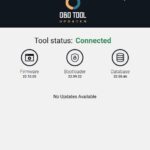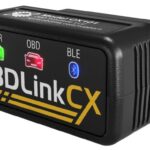Since 1996, On-Board Diagnostics II (OBD2) systems have become a standard feature in all new cars, mandated to enhance emissions diagnostics. For BMW 318i owners, understanding and utilizing the OBD2 system can be a game-changer in vehicle maintenance and troubleshooting. While older BMW models (198X-1995) used the earlier OBD-I system, OBD2 offers a more advanced and user-friendly interface for accessing your car’s health information. This guide will walk you through everything you need to know about your BMW 318i OBD2 port location and how to make the most of it for effective car diagnostics.
Understanding the OBD2 System in Your BMW 318i
The OBD2 system was primarily developed to tackle emissions issues by quickly pinpointing malfunctioning components within the fuel injection system. However, its capabilities extend far beyond just emissions. It provides a wealth of data about your BMW 318i’s engine, transmission, and other vital systems. In the past, accessing this information required expensive, specialized equipment. Today, OBD2 scanners and software have become remarkably affordable, putting the power of automotive diagnostics directly into the hands of BMW 318i owners and DIY enthusiasts.
The accessibility of OBD2 tools means you can now diagnose potential problems with your BMW 318i without constant trips to the mechanic. This saves both time and money, allowing you to proactively maintain your vehicle and address issues early on. Don’t let anyone tell you modern cars are too complex for home mechanics. The OBD2 system actually simplifies diagnostics by providing specific error codes and sensor readings, removing much of the guesswork from troubleshooting, especially compared to pre-OBD2 era vehicles.
Locating the OBD2 Port in Your BMW 318i
The first step to leveraging the OBD2 system is finding the port itself in your BMW 318i. Fortunately, it’s typically in a readily accessible location. For most BMW 318i models, the OBD2 port is situated in the driver’s footwell area.
Specifically, you’ll want to look on the lower left side, beneath the dashboard and near the steering column. In most BMW 318i models, you might find a small cover that needs to be flipped open to reveal the OBD2 port. Sometimes, there’s a plastic connector cover on the port itself that you’ll need to pull off before connecting your OBD2 scanner.
Once you’ve located the port, connecting an OBD2 scanner is straightforward. Simply plug the scanner’s adapter into the OBD2 port. If you’re using a laptop-based system, you’ll then connect a cable from the adapter to your laptop, which can be conveniently placed on the passenger seat.
Figure 1: The OBD2 port location is typically found in the driver’s side footwell of a BMW 318i.
Figure 2: Connecting an OBD2 adapter and cable to the OBD2 port in a BMW 318i for diagnostics.
Choosing the Right OBD2 Scanner for Your BMW 318i
With the OBD2 port located, the next step is selecting an OBD2 scanner that suits your needs and budget. The market offers a wide range of options, from basic handheld scanners to sophisticated laptop-based software.
Basic Handheld Scanners: These are the most affordable and user-friendly options. They are great for reading basic fault codes and clearing them. Ideal for quick checks and simple diagnostics on your BMW 318i.
Mid-Range Handheld Scanners: These offer more advanced features like live data streaming, freeze frame data, and sometimes even enhanced manufacturer-specific codes for BMW. A good balance of features and price for the DIY BMW 318i owner.
Laptop or PC-Based Software: For the most comprehensive diagnostics, software like AutoEnginuity (mentioned in the original article) paired with a laptop provides extensive capabilities. These systems often offer:
- Live Data Monitoring: View real-time sensor data (oxygen sensors, RPM, temperature, etc.) in customizable displays.
- Data Logging: Record sensor data for later analysis, useful for intermittent problem diagnosis in your BMW 318i.
- Graphing: Visualize sensor data trends to identify patterns and anomalies.
- On-Board Test Results: Access results of internal diagnostic tests performed by the BMW 318i’s computer.
- Performance Measurement Tools: Some software includes tools to estimate performance metrics like horsepower and 0-60 mph times.
Smartphone App-Based Scanners: Utilizing Bluetooth or Wi-Fi OBD2 adapters, these apps turn your smartphone into a diagnostic tool. They range in features and price, offering a convenient and portable option.
When choosing, consider your budget, diagnostic needs, and technical comfort level. For BMW 318i owners wanting in-depth analysis, laptop-based systems offer the most power. For basic code reading and clearing, a handheld scanner might suffice.
Utilizing OBD2 Scanner Functions for BMW 318i Diagnostics
Once you have your OBD2 scanner connected to your BMW 318i, you can start exploring its diagnostic capabilities. Here’s a look at some key functions:
Reading Fault Codes: When your BMW 318i’s check engine light illuminates, the OBD2 system stores diagnostic trouble codes (DTCs). These codes pinpoint the area of the problem (e.g., P0171 – System Too Lean, Bank 1). Your scanner will display these codes, giving you a starting point for troubleshooting.
Clearing Fault Codes: After addressing the issue and verifying the repair, you can use your scanner to clear the fault codes and turn off the check engine light. However, remember to properly diagnose and fix the underlying problem first; simply clearing codes without repair is a temporary fix.
Live Data Monitoring: This powerful feature allows you to observe real-time data from your BMW 318i’s sensors while the engine is running. You can monitor parameters like:
- Oxygen Sensor Readings: Crucial for assessing fuel mixture and catalytic converter efficiency.
- Engine RPM: Engine speed in revolutions per minute.
- Coolant Temperature: Engine operating temperature.
- Intake Air Temperature: Temperature of air entering the engine.
- Ignition Timing Advance: Timing of spark plug firing.
- Fuel Trim: Adjustments made to the fuel mixture by the engine control unit (ECU).
Figure 3: An example of a live data screen from OBD2 software, showing real-time sensor readings for a BMW.
Analog Dashtop View: Some software offers a “Dashtop” or gauge view, displaying sensor data in an analog gauge format, mimicking traditional car gauges. This can be useful for quick visual monitoring while driving (passenger should operate the software, not the driver).
Figure 4: A dashtop style display in OBD2 software, showing sensor readings in an analog gauge format.
Graphing Sensor Data: Visualizing sensor data over time through graphs can reveal trends and intermittent issues that are hard to spot in raw data readings. Comparing graphs of related sensors can be particularly insightful.
Figure 5: Graphing capabilities in OBD2 software allow for visual analysis of sensor data over time.
Oxygen Sensor Specific Tests: Many scanners have dedicated screens for monitoring oxygen sensor performance, as these sensors are vital for engine efficiency and emissions control.
Figure 6: Dedicated screens in OBD2 software for monitoring oxygen sensor performance and readings.
On-Board Test Results: The OBD2 system performs internal tests on various components. Scanners can access the results of these tests, providing further diagnostic information.
Figure 7: Accessing on-board test results within OBD2 software for comprehensive system diagnostics.
Performance Measurement with OBD2
Beyond diagnostics, some OBD2 software packages include performance measurement tools like “SpeedTracer.” These tools use OBD2 data (RPM, speed, ambient temperature) and vehicle profiles to estimate horsepower, torque, 0-60 mph times, and quarter-mile times. While not as precise as a dynamometer, these tools can be fun for enthusiasts and provide a relative measure of performance changes after modifications.
Conclusion
The OBD2 system is a powerful asset for any BMW 318i owner. Knowing the OBD2 port location and how to use a scanner empowers you to understand your car’s health, diagnose issues effectively, and save money on maintenance. Whether you choose a basic handheld scanner or a comprehensive laptop-based system, embracing OBD2 diagnostics is a smart move for maintaining your BMW 318i and enjoying confident, informed car ownership.

